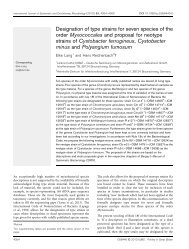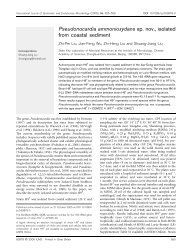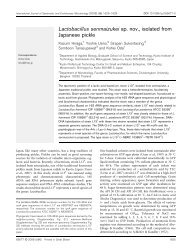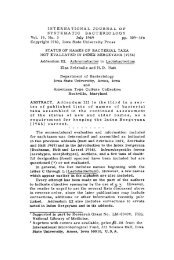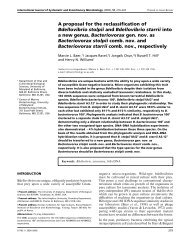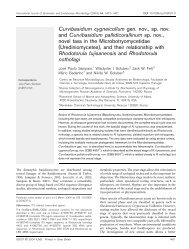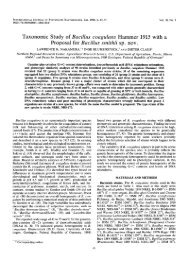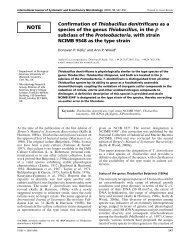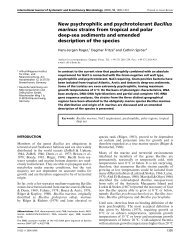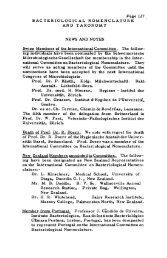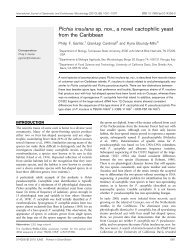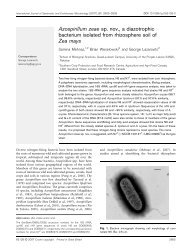Providencia heimbachae, a New Species of Enterobacteriaceae ...
Providencia heimbachae, a New Species of Enterobacteriaceae ...
Providencia heimbachae, a New Species of Enterobacteriaceae ...
Create successful ePaper yourself
Turn your PDF publications into a flip-book with our unique Google optimized e-Paper software.
VOL. 36, 1986 PROVIDENCIA HEIMBACHAE SP. NOV. 253<br />
TABLE 1. List <strong>of</strong> <strong>Providencia</strong> <strong>heimbachae</strong> strains studied<br />
Straina<br />
CDC 8025-83T<br />
(= MUA 2-llOT<br />
= ATCC 35613*)<br />
CDC 8027-83<br />
(= MUA 1-152)<br />
CDC 8032-83<br />
(= MUA 1-154)<br />
CDC 8035-83<br />
(= MUA 1-134)<br />
CDC 8039-83<br />
(= MUA 1-140)<br />
CDC 8050-83<br />
(= MUA 1-135)<br />
CDC 8051-83<br />
(= MUA 1-136)<br />
CDC 8052-83<br />
(= MUA 1-138)<br />
CDC 8053-83<br />
(= MUA 1-139)<br />
CDC 8054-83<br />
(= MUA 1-150)<br />
CDC 8055-83<br />
(= MUA 1-151)<br />
CDC 8056-83<br />
(= MUA 2-202)<br />
CDC 1519-73<br />
(enteric group<br />
78)<br />
Isolated from:<br />
<strong>Species</strong> <strong>of</strong> penguin Source<br />
Aptenodytes patagonica Feces<br />
Aptenodytes patagonica<br />
Aptenodytes patagonica<br />
Spheniscus humboldti<br />
Spheniscus demersus<br />
Spheniscus humboldti<br />
Spheniscus humboldti<br />
Spheniscus demersus<br />
Spheniscus demersus<br />
Aptenodytes patagonica<br />
Aptenodytes patagonica<br />
Aptenodytes patagonica<br />
Feces<br />
Feces<br />
Feces<br />
Feces<br />
Feces<br />
Feces<br />
Feces<br />
Feces<br />
Feces<br />
Feces<br />
Feces<br />
Aborted bovine<br />
fetus<br />
' CDC, Centers for Disease Control, Atlanta, Ga.; MUA, Staatliches<br />
Medizinaluntersuchungsamt, Braunschweig, Federal Republic <strong>of</strong> Germany;<br />
ATCC, American Type Culture Collection, Rockville, MD.<br />
Clinical Laboratory Standards (14, 15). The drugs tested<br />
were supplied by the manufacturers. Ampicillin, carbenicillin,<br />
piperacillin, mezlocillin, ticarcillin, cephalothin,<br />
cefazolin , cefamandole, cefoxitin, cefuroxime, cefoperazone,<br />
cefotaxime, ceftazidime, moxalactam, ceftriaxone,<br />
gentamicin, amikacin, tobramycin, netilmicin, tetracycline,<br />
sulfamethoxazole-trimethoprim, sulfisoxazole, trimethoprim,<br />
and chloramphenicol were tested by both methods.<br />
Azlocillin, doxycycline, nalidixic acid, cinoxacin, nitr<strong>of</strong>urantoin,<br />
imipenem, and aztreonam were tested by the broth<br />
microdilution method only.<br />
DNA relatedness. Levels <strong>of</strong> DNA relatedness were determined<br />
by reacting 32P-labeled DNA from <strong>Providencia</strong><br />
<strong>heimbachae</strong> 8025-83T (T = type strain) with unlabeled DNAs<br />
from the 12 other <strong>Providencia</strong> <strong>heimbachae</strong> strains and other<br />
strains <strong>of</strong> interest (Table 2), using methods described elsewhere<br />
(2, 9, 10).<br />
RESULTS AND DISCUSSION<br />
Isolation <strong>of</strong> bacterial strains. Twelve <strong>of</strong> the <strong>Providencia</strong><br />
<strong>heimbachae</strong> strains were isolated from the feces <strong>of</strong> apparently<br />
healthy penguins, and one strain was isolated from an<br />
aborted bovine fetus (Table 1). The habitat <strong>of</strong> the new<br />
species seems to be the same as or similar to the habitat <strong>of</strong><br />
<strong>Providencia</strong> rustigianii, and <strong>Providencia</strong> <strong>heimbachae</strong> has<br />
been isolated frequently from the same animal sources,<br />
although it has not yet been isolated from humans. Its<br />
estimated occurrence in relation to that <strong>of</strong> <strong>Providencia</strong><br />
rustigianii is l:lO, which corresponds to the numbers isolated<br />
from penguins (12) as well as to the numbers <strong>of</strong> strains<br />
in the collection at the Centers for Disease Control (9).<br />
TABLE 2. Levels <strong>of</strong> DNA relatedness <strong>of</strong> <strong>Providencia</strong><br />
<strong>heimbachae</strong> ATCC 35613T to 12 other <strong>Providencia</strong> <strong>heimbachae</strong><br />
strains and strains belonging to other speciesu<br />
Relatedness to labeled DNA from<br />
<strong>Providencia</strong> <strong>heimbachae</strong> ATCC 35613T<br />
Relative Relative<br />
Source <strong>of</strong> unlabeled DNA binding Divergence binding<br />
ratio at<br />
60°C<br />
(%Y<br />
ratio at<br />
75°C<br />
(%Ib<br />
<strong>Providencia</strong> <strong>heimbachae</strong><br />
ATCC 35613T<br />
100 0.0 100<br />
<strong>Providencia</strong> <strong>heimbachae</strong> 100 0.5 100<br />
8027-83<br />
<strong>Providencia</strong> <strong>heimbachae</strong><br />
8039-83<br />
100 1 .o 99<br />
<strong>Providencia</strong> <strong>heimbachae</strong><br />
8050-83<br />
100 0.0 100<br />
<strong>Providencia</strong> <strong>heimbachae</strong><br />
8051-83<br />
100 0.5 100<br />
<strong>Providencia</strong> <strong>heimbachae</strong><br />
8052-83<br />
100 0.0 100<br />
Pro v idencia he im ba c ha e<br />
8053-83<br />
100 0.0 99<br />
<strong>Providencia</strong> <strong>heimbachae</strong><br />
8054-83<br />
100 0.0 99<br />
<strong>Providencia</strong> <strong>heimbachae</strong><br />
8055-83<br />
100 0.0 100<br />
<strong>Providencia</strong> <strong>heimbachae</strong><br />
8056-83<br />
100 0.0 100<br />
<strong>Providencia</strong> <strong>heimbachae</strong><br />
8032-83<br />
99 0.5 100<br />
<strong>Providencia</strong> heim ba c hae 99 0.5 100<br />
8035-83<br />
<strong>Providencia</strong> <strong>heimbachae</strong><br />
1519-73<br />
91 0.0 N D ~<br />
<strong>Providencia</strong> rustigianii<br />
0132-68T<br />
45 6.5 31<br />
<strong>Providencia</strong> alcalifaciens<br />
3370-67<br />
28 14.5 ND<br />
Pro v idencia re ttg e ri<br />
24 13.5<br />
6<br />
1163T<br />
<strong>Providencia</strong> stuartii<br />
2896-68<br />
22 15 .O<br />
4<br />
Proteus mirabilis PR-14 13 15.0 ND<br />
Proteus myx<strong>of</strong>aciens<br />
ATCC 19692T<br />
11 16.0 ND<br />
Proteus vulgaris PR-1<br />
10 16.0 ND<br />
Morganella morganii<br />
9 14.5 ND<br />
ATCC 25830T<br />
Escherichia coli K-12<br />
5 ND ND<br />
a Labeled DNA was reacted with unlabeled DNA from the same strain<br />
(homologous reaction) and with DNAs from other strains (heterologous<br />
reactions). Each reaction was done at least twice. Before normalization, the<br />
level <strong>of</strong> reassociation in homologous reactions averaged 55%. Control reac-<br />
tions, in which labeled DNA was incubated in the absence <strong>of</strong> unlabeled DNA,<br />
resulted in 0.5 to 1.5% binding to hydroxyapatite. These control values were<br />
subtracted before normalization.<br />
Relative binding ratios were determined as follows: [(percentage <strong>of</strong> DNA<br />
bound to hydroxyapatite in heterologous reaction)/(percentage <strong>of</strong> DNA bound<br />
to hydroxyapatite in homologous reaction)] x 100.<br />
Divergence was calculated on the assumption that a 1% decrease in the<br />
thermal stability <strong>of</strong> a heterologous DNA duplex compared with the thermal<br />
stability <strong>of</strong> the homologous DNA duplex was caused by 1% <strong>of</strong> the bases within<br />
the duplex that were unpaired; divergence was calculated to the nearest 0.5%.<br />
Np, Not determined.<br />
&1'<br />
DNA hybridization. Labeled DNA from the type strain<br />
<strong>of</strong> <strong>Providencia</strong> <strong>heimbachae</strong> was 91 to 100% related to DNAs<br />
from the 12 other <strong>Providencia</strong> <strong>heimbachae</strong> strains in DNA<br />
relatedness reactions done at 60°C. There was 0 to 0.5%



